NEEP602 Course Notes (Fall 1996)
Resources from Space
 Venus
Venus

Venus Facts
- Venus is the second planet from the Sun and the sixth largest:
- distance from Sun: (0.72 AU)
- diameter: 12,103.6 km (0.0008AU)
- mass: 4.869e24 kg (compare w/ 5.97e24kg Earth)
- density: 5.25 gm/cc (compare w/ Earth 5.52)
- no magnetic field
- rotation rate is 243 Earth days/ retograde
- revolution rate around the axis of the planet is 224.7 days
- obliquity to the plane of the ecliptic is 178 degrees
- surface may be as little as 500 My old from crater counts per unit area & random distribution of craters
- no cold (trap) region in the present atmosphere to condense water and prevent its loss (especially hydrogen from dissociation of water) into space (escape velocity Venus 10.4 km/sec, Earth 11.2km/sec), hence very little water now
- absence of water may make similar rocks stronger than on Earth by factor of 10
- crude estimate of heat flow, if like Earth, 1-1.5 cal/cm2/sec mainly from radio active decay but no plate tectonics (unlike Earth, unimodal topography vs elevation) to make escape of heat easy.
- no life now
The planet is so named probably because it is the brightest of the planets known to the ancients.
- Venus is only slightly smaller than Earth (95% of Earth's diameter, 80% of Earth's mass).
- Both have few craters indicating relatively young surfaces.
- Their densities and chemical compositions are similar.
Pictures
- (above) False color high-res image a whole hemisphere
342k gif;
3000k gif
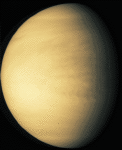 Visible light view from Galileo
73k gif
Visible light view from Galileo
73k gif
 Sif Mons
156k gif;
270k jpg
Sif Mons
156k gif;
270k jpg
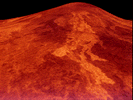 Recent Volcanism
123k gif;
22k jpg
Recent Volcanism
123k gif;
22k jpg
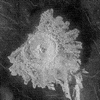 Large Impact Crater
131k gif;
495k jpg
Large Impact Crater
131k gif;
495k jpg
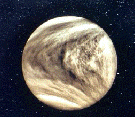 Image from Pioneer Venus
15k jpg
Image from Pioneer Venus
15k jpg
- Gula Mons and Cunitz crater
250k gif;
178k jpg
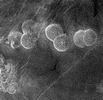 7 pancake volcanoes, alpha region
227k gif;
327k jpg
7 pancake volcanoes, alpha region
227k gif;
327k jpg
 Pandora Corona, Lada Terra 42.5 deg S 6 lon
177k gif;
186k jpg
Pandora Corona, Lada Terra 42.5 deg S 6 lon
177k gif;
186k jpg
- Vires-Akka Chasma, Denitsa Region 130k gif; 337k jpg
- Crater Farm, Lavinia Region, small 107k gif; 147k jpg
- Volcano, 3 mile diameter, paragon chasma, 9.4S by 247.5 long 282k gif; 72k jpg
- Golubkina crater, 60.5 Deg N, 287.2 Long (computer generated Perspective) 107k gif; 149k jpg
- Alpha Regio, showing hills and craters
237k gif
 UV image from HST (false color)
23k jpg;
99k gif;
1200k tiff
UV image from HST (false color)
23k jpg;
99k gif;
1200k tiff
- New Magellan global mosaics
html
 Surface photographs from the Soviet Venera 9 and 10 spacecraft
Surface photographs from the Soviet Venera 9 and 10 spacecraft
- NASA PDS Magellan Image Browser html
- ... more Venus images
Movies
- Venus animation 1542K fli; 1239K pics; 405K quicktime; 444K B&W pics
- Venus Globe Animation 303k mpeg
- Earth/Venus Rotation Movie 1000k AVI
- Magellan - Mapping the planet Venus 10000k AVI
- Flight over Western Atla Regio 7000k AVI; (caption)
- Flight over Artemis 11000k AVI; 23000k AVI; (caption)
- Flight over Alpha Regio 8000k AVI; (caption)
- Flight over Western Eistla Regio - 3300k AVI; 7600k AVI; 15000k AVI; (caption)
- A dramatic view the the moon with Venus in the distance 82k mpeg
More about Venus
- from ASU
- from LANL
- from JPL
- from RPIF
- from RGO
- from NSSDC
- from NASA Spacelink
- Venus papers and info from MIT
- Magellan mission home page
- The Face of Venus: surface of the planet Venus through hypertext documents and the interactive databases of craters and coronae. (Very nice!)
- Venusian Craters and Venusian Volcanic Features from LANL
- Magellan Venus Explorer's Guide from JPL; about Magellan and Venus prior to the Magellan data
- Guide to Magellan Image Interpretration from JPL
- Magellan Highlights of Venus (ExInEd Hypercard stack)
- Dr. Cain's class notes
- The Magellan Spacecraft at Venus by Andrew Fraknoi of ASP
- Venus Nomenclature Table
Open Issues
- There is some evidence of spreading and folding on Venus's surface and of recent volcanic flows. But there is no evidence of plate tectonics as seen on Earth. Is this a result of the higher surface temperature?
- The greenhouse effect is much stronger on Venus than Earth because of Venus's dense carbon dioxide atmosphere. But why did Venus evolve so differently from Earth?
Bill Arnett; original source: 1995 August 12
Revised for 602/376 by R. P. Meyer, February 19, 1996
 |
|
University of Wisconsin Fusion Technology Institute · 439 Engineering Research Building · 1500 Engineering Drive · Madison WI 53706-1609 · Telephone: (608) 263-2352 · Fax: (608) 263-4499 · Email: fti@engr.wisc.edu |
Copyright © 2003 The Board of
Regents of the University of Wisconsin System.
For feedback or accessibility issues, contact
web@fti.neep.wisc.edu.
|
